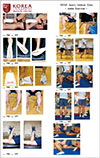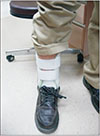Abstract
As a result of the increased participation in recreational and competitive sports activity, the incidence of chronic lateral instability has risen. Because chronic ankle instability can cause significant comorbidity and increase the social cost, the interest in this issue is growing. Although there are well-documented and effective surgical treatments for managing this condition, conservative treatments are a viable first option in selected patients. Through conservative treatment, surgical treatments can be reduced or delayed without necessarily affecting the overall outcome, but the failure of conservative treatment results in the need for surgical treatment to reduce the long term complications. Appropriate postoperative rehabilitation is essential for adequate functional recovery, even when surgical treatment is required.
Figures and Tables
Figure 1
Ultrasonography of anterior talofibular ligament (arrowheads). (A) Relaxed. (B) Stressed. By applying stress, the condition of the ligament can be known in real time. LM: lateral malleolus.

Figure 8
Example of the manual of the home exercise for the conservative treatment of chronic lateral ankle instability. rep: repeat.

References
1. Hockenbury RT, Sammarco GJ. Evaluation and treatment of ankle sprains: clinical recommendations for a positive outcome. Phys Sportsmed. 2001; 29:57–64.
2. Anandacoomarasamy A, Barnsley L. Long term outcomes of inversion ankle injuries. Br J Sports Med. 2005; 39:e14.
4. Kannus P, Renström P. Treatment for acute tears of the lateral ligaments of the ankle. Operation, cast, or early controlled mobilization. J Bone Joint Surg Am. 1991; 73:305–312.

5. Konradsen L. Factors contributing to chronic ankle instability: kinesthesia and joint position sense. J Athl Train. 2002; 37:381–385.
6. Thompson C, Schabrun S, Romero R, Bialocerkowski A, van Dieen J, Marshall P. Factors contributing to chronic ankle instability: a systematic review and meta-analysis of systematic reviews. Sports Med. 2018; 48:189–205.

7. Miyamoto W, Takao M, Yamada K, Matsushita T. Accelerated versus traditional rehabilitation after anterior talofibular ligament reconstruction for chronic lateral instability of the ankle in athletes. Am J Sports Med. 2014; 42:1441–1447.

9. Tropp H, Odenrick P, Gillquist J. Stabilometry recordings in functional and mechanical instability of the ankle joint. Int J Sports Med. 1985; 6:180–182.

10. Freeman MA. Instability of the foot after injuries to the lateral ligament of the ankle. J Bone Joint Surg Br. 1965; 47:669–677.
11. Bernier JN, Perrin DH, Rijke A. Effect of unilateral functional instability of the ankle on postural sway and inversion and eversion strength. J Athl Train. 1997; 32:226–232.
12. Knupp M, Lang TH, Zwicky L, Lötscher P, Hintermann B. Chronic ankle instability (medial and lateral). Clin Sports Med. 2015; 34:679–688.

13. Patankar HP, Yeo ED, Kim SJ, Lim HC, Hwang MH, Park S, et al. Novel balance tests for assessing functional ankle instability: relationships with BMI and gender. J Korean Foot Ankle Soc. 2012; 16:128–134.
14. Kobayashi T, Gamada K. Lateral ankle sprain and chronic ankle instability: a critical review. Foot Ankle Spec. 2014; 7:298–326.
15. McKeon PO, Ingersoll CD, Kerrigan DC, Saliba E, Bennett BC, Hertel J. Balance training improves function and postural control in those with chronic ankle instability. Med Sci Sports Exerc. 2008; 40:1810–1819.

16. Webster KA, Gribble PA. Functional rehabilitation interventions for chronic ankle instability: a systematic review. J Sport Rehabil. 2010; 19:98–114.

17. Rodriguez-Merchan EC. Chronic ankle instability: diagnosis and treatment. Arch Orthop Trauma Surg. 2012; 132:211–219.

18. Lee SH, Yun SJ. The feasibility of point-of-care ankle ultrasound examination in patients with recurrent ankle sprain and chronic ankle instability: comparison with magnetic resonance imaging. Injury. 2017; 48:2323–2328.

19. Lee KT, Park YU, Jegal H, Park JW, Choi JP, Kim JS. New method of diagnosis for chronic ankle instability: comparison of manual anterior drawer test, stress radiography and stress ultrasound. Knee Surg Sports Traumatol Arthrosc. 2014; 22:1701–1707.

20. Hermans JJ, Wentink N, Beumer A, Hop WC, Heijboer MP, Moonen AF, et al. Correlation between radiological assessment of acute ankle fractures and syndesmotic injury on MRI. Skeletal Radiol. 2012; 41:787–801.

21. Hale SA, Hertel J, Olmsted-Kramer LC. The effect of a 4-week comprehensive rehabilitation program on postural control and lower extremity function in individuals with chronic ankle instability. J Orthop Sports Phys Ther. 2007; 37:303–311.

22. DiGiovanni CW, Brodsky A. Current concepts: lateral ankle instability. Foot Ankle Int. 2006; 27:854–866.

23. Tully MA, Bleakley CM, O'Connor SR, McDonough SM. Functional management of ankle sprains: what volume and intensity of walking is undertaken in the first week postinjury. Br J Sports Med. 2012; 46:877–882.

24. Richie DH Jr. Functional instability of the ankle and the role of neuromuscular control: a comprehensive review. J Foot Ankle Surg. 2001; 40:240–251.

25. Valovich McLeod TC. The effectiveness of balance training programs on reducing the incidence of ankle sprains in adolescent athletes. J Sport Rehabil. 2008; 17:316–323.

26. DIGiovanni BF, Fraga CJ, Cohen BE, Shereff MJ. Associated injuries found in chronic lateral ankle instability. Foot Ankle Int. 2000; 21:809–815.

28. Löfvenberg R, Kärrholm J, Lund B. The outcome of nonoperated patients with chronic lateral instability of the ankle: a 20-year follow-up study. Foot Ankle Int. 1994; 15:165–169.

29. Puls A, Gribble P. A comparison of two Thera-band training rehabilitation protocols on postural control. J Sport Rehabil. 2007; 16:75–84.

30. Uchida MC, Nishida MM, Sampaio RA, Moritani T, Arai H. Thera-band(®) elastic band tension: reference values for physical activity. J Phys Ther Sci. 2016; 28:1266–1271.

31. Bae CH, Jeong YW, Lee JH. Analysis of muscle activations in lower extremities muscles at various angles of ankle flexion using wedges during static squat exercise. J Phys Ther Sci. 2015; 27:2853–2855.

32. Fusco A, Giancotti GF, Fuchs PX, Wagner H, Varalda C, Cortis C. Wobble board balance assessment in subjects with chronic ankle instability. Gait Posture. 2019; 68:352–356.

33. Verhagen E, van der Beek A, Twisk J, Bouter L, Bahr R, van Mechelen W. The effect of a proprioceptive balance board training program for the prevention of ankle sprains: a prospective controlled trial. Am J Sports Med. 2004; 32:1385–1393.

34. Lee JH, Yoon TL. Effective treatment for chronic ankle instability during lateral step-down - kinesiology tape, resistance exercise, or both accompanied with heel raise-lower exercise? J Sport Rehabil. 2018; DOI: 10.1123/jsr.2018-0073. Published online December 11, 2018.
35. Loudon JK, Santos MJ, Franks L, Liu W. The effectiveness of active exercise as an intervention for functional ankle instability: a systematic review. Sports Med. 2008; 38:553–563.





 PDF
PDF ePub
ePub Citation
Citation Print
Print












 XML Download
XML Download